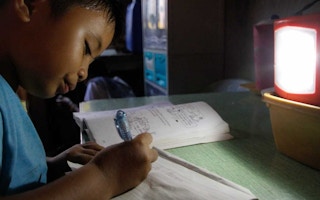It’s time to redesign the Philippine electricity sector. Electricity rates in the country are among the highest in Southeast Asia, due in large part to our dependence on expensive imported diesel, oil and coal.
To continue reading, subscribe to Eco‑Business.
There's something for everyone. We offer a range of subscription plans.
- Access our stories and receive our Insights Weekly newsletter with the free EB Member plan.
- Unlock unlimited access to our content and archive with EB Circle.
- Publish your content with EB Premium.
But it doesn’t have to stay this way. There are economically sensible domestic options that can help lower electricity prices across the Philippines—provided the government is willing to lead us into a far more efficiently-powered future economy, rather than opting to live in the past.
Increasing competition, cutting diesel subsidies, ending fuel cost “pass through”, holding fuel agnostic reverse auctions and requiring carve-out clauses in power deals would go a long way towards delivering cheaper and more reliable power for all.
Ratepayers already bearing the costs
Power for small islands has cost the government—and ultimately taxpayers—over P10 billion in subsidies for imported diesel fuel, even though many small island grids served by diesel generators suffer from blackouts.
That money should instead be used to build hybrid solar/wind-integrated systems with diesel backup or to go fully solar/wind with storage options, hydropower, geothermal, or biomass. Our study last year in cooperation with the Institute for Climate and Sustainable Cities shows that doing this can save the Philippines over P10 billion pesos per year.
A similar situation exists for larger islands’ coal-dominated generation mix. The Philippines has bet big on coal, with 7,419 megawatts (MW) of existing coal-fired generation and another 10,423 MW in the development pipeline approved by the Aquino administration.
Stranding is already starting to take place in Mindanao even without retail competition enabled by the presence of a Wholesale Electricity Spot Market. This means that the excess of approximately 700 MW of coal coal-fired power in the region has led to a downtrend in utilisation rates as compared to original expectations.
Conservatively speaking, the underutilisation cost in Mindanao alone from 2014 to 2016 is P3 billion (US$5.7 million). Unfortunately, this cost is being borne by the public. Even worse, over P1 trillion (US$21 billion) worth of coal plant assets in the country’s pipeline face progressive stranding, leaving us at much greater risk.
Competition
In the face of rapidly declining costs and technological advances in renewable energy and storage, reliance on coal makes less and less sense. Unfortunately, the Philippines’ growing dependence on imported coal is tied directly to regulatory practices that act as implicit subsidies that perpetuate market distortions.
The cost of coal can range from P3.8 to P5.5 (US$.07 to US$0.11) per kilowatt hour (kWh) and continues to rise. In contrast, the lowest price for solar received by Meralco, the country’s biggest electricity company, so far has been P2.99/kWh (US$ .06/kWh) for a 50-MW capacity plant.
Meralco likewise received the lowest ever bid in March 2018 to build 150 MW of wind in Rizal at PhP 3.50/kWh (US$.07/kWh). IEEFA forecasts solar deflation of around 10 per cent annually for the next five years, the sooner the Philippines pivots toward this option, the faster the deflation for consumers.
Companies supplying our electricity are insulated almost completely against changing market dynamics. The multi-billion peso indirect subsidies stand as perverse incentives that encourage the use of high cost, inefficient coal power.
It is high time for regulators and legislators to usher in genuine competition to provide people with more affordable and reliable domestic renewable power. This entails introducing competitive bidding via reverse auctions and removing the ability for generators to automatically pass-through fuel and foreign exchange fluctuations.
Ending “pass through”
In 2016, the Panay Energy Development Corporation, a Meralco power supplier, signed up to a deal to deliver coal-fired power at P3.96/kWh (US$0.08/kWh). But because of rules that allow coal operators to game the competitive arena, the actual cost to Panay consumers was 37 per cent higher at P5.41/kWh (US$0.10/kWh).
How was this possible? Simple. Under current regulations, fossil fuel companies like Panay are allowed to pass extra fuel costs or foreign exchange fluctuations directly on to the customer at any time.
This practice needs to stop. A deal should be a deal: companies need to deliver what they committed from the outset. Doing so would force companies to put an honest price on the real cost of their power, based on projections spanning at least five years into the future. Unfortunately, this is something coal companies are afraid to do as it will draw the obvious conclusion that renewable energy is cheaper.
Requiring carve out clauses
It is also time for the Department of Energy to make carve-out clauses in power supply agreements mandatory. A carve-out clause can reduce the amount of power a utility must buy from a (more expensive coal) power generator and exempt distribution utilities from the consequences of coal-plant overbuilding and high coal costs.
The clause could protect captive Philippine industry customers and other ratepayers from having to foot the bill for generator costs when other companies, under the country’s retail competition and open access program, turn to cheaper suppliers.
Meralco, which has lost 20 per cent of its energy sales in 2016/2017 as a result of defecting contestable customers, had the foresight to put a carve-out clause in its new power supply agreements, recognising the need to protect ratepayers from stranded coal plants by shifting the risks back on to the independent power providers and their investors.
Conclusion
High electricity prices is a policy failure in the face of declining costs of renewable energy and storage. A private-sector led economy like the Philippines needs to
ensure a competitive market by holding fuel agnostic reverse auctions and requiring carve-out clauses in power deals, as well as a removal of perverse incentives by ending ‘pass through’ rules and removing unnecessary subsidies paid for by the public.
It is time to realise the pace of technological advancements and its impact on global markets—electricity should no longer be expensive. A more competitive market will go a long way to delivering cheaper, more reliable power for all.
Sara Jane Ahmed is an energy finance analyst of the Institute for Energy Economics and Financial Analysis (IEEFA). She is a former investment advisor specialising in originating and structuring energy opportunities in emerging markets.









